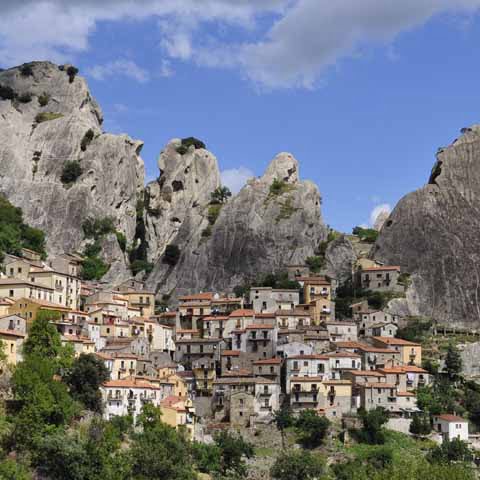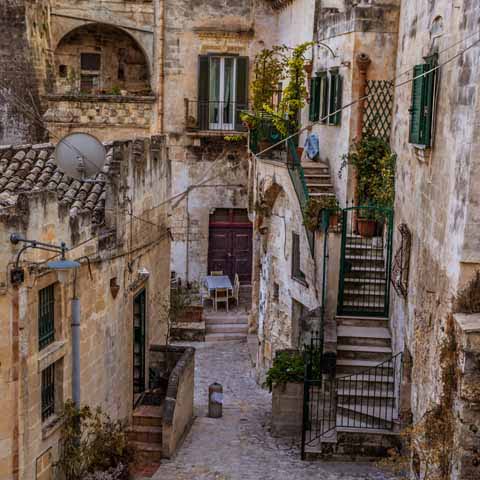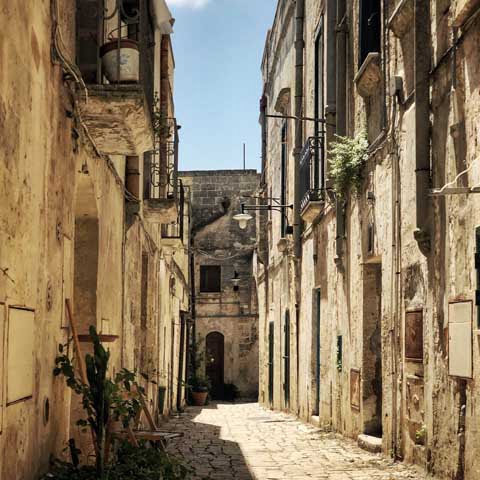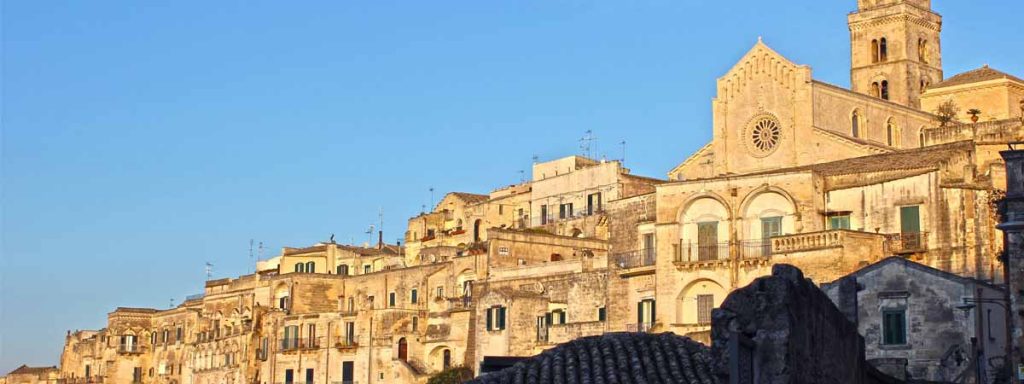Potenza, located on the top of a mountain ridge that runs parallel to the course of the Basento River, is the highest regional capital in peninsular Italy. Its demographic and urban development was rather modest until the second half of the nineteenth century, when the city began a slow but steady expansion beyond the city walls.
At first glance, the urban agglomeration gives the impression of a sober and modern city, characterized by new buildings erected in the last few decades. Yet, behind these expansion works lies the ancient heart of the city, a place full of fascinating history and ancient testimonies.
Seriously damaged during World War II and then almost razed to the ground by the earthquake in 1980, today’s Potenza is a lively city, a bishopric center, and a university seat.
PREHISTORY OF POTENZA
Potenza has ancient origins, though uncertainty shadows the exact details of its origins. The area was perhaps inhabited by the ancestors of the Lucanians, tribes of fierce warriors, or by the Sabellians. Even if there is not clear evidence, it is believed that Potenza emerged as a Greek military outpost during the colonization of Magna Graecia, which was later transformed into a permanent settlement.
What is certain is that the Italic tribes of the Lucanians inhabited the settlement, protecting it from foreign influence until the arrival of the Romans.
Sadly, Potenza is not rich in archaeological evidence that attests to the dynamics and the evolution of the territory in the prehistoric age.
HISTORY OF POTENZA
Potenza, inhabited by the Lucanians, remained a free territory until the Roman conquest, when the Lucanians were defeated, but not subdued. The population, though hostile to foreign interventions, sided with Rome until the Punic Wars in the third century BC.
During the wars, Potenza sided with Hannibal, showing loyalty to the Punic ruler until defeated. The Punics had no choice but to return to Africa. Left alone, Potenza was subjected to the revenge of the Romans, who ruthlessly downgraded the settlement from municipium to praefectura.
However, the Romans recognized the geographical and strategic importance of Potenza which, with the inauguration of new military roads, was connected to many neighboring municipalities.
Under Rome, the city had a long period of peace and prosperity, especially in the Augustan age. In this period, Potenza received numerous public buildings and many infrastructure works were carried out in the territory. Some of the most important vestiges of the era are the Roman Bridge and the Villa of Malvaccaro.
However, during the Roman period, the city followed the vicissitudes of the empire, without shining much of its own light. The fall of the empire meant the beginning of a period of decadence and ruin, caused primarily by the barbarian invasions.
With the advent of the Byzantines, the region of Basilicata was established, named after the basilicas, or administrators of the lands. At the time, the region coincided with today’s province of Potenza, and the city became the capital of the region.
While exceptional events do not characterize the Byzantine period, the same cannot be said about the Norman period.
Under the Normans, Potenza gained a strategic importance with the arrival of Pope Innocent II, in 1137. The city gained further importance in the upcoming decade, welcoming the troops returning from an unfortunate expedition to the Holy Land. In fact,
Potenza was a particularly important center for the clergy.
One of the most important bishops of the city was Gerard of Potenza. Sanctified in 1119, Saint Gerard is the spiritual patron of the city, and his relics are held in the Cathedral of Potenza.
During this time, Potenza sided with the Swabians from a political point of view. But in 1268, Conradin, the Duke of Swabia, was beheaded in Naples and the revenge of Charles I of Anjou on the cities that sustained the German dynasty was harsh and fierce. Potenza was razed to the ground. Shortly thereafter, in 1273, an earthquake contributed to aggravating the already precarious economic situation, followed by subsequent reactions from the Anjou.
In 1304, the fiefdom of Potenza was granted to Robert of Anjou. The rest of the century was not marked by exceptional events until the 1390s, when King Ladislaus, contesting the kingdom to his cousin Louis of Anjou, besieged the city, but used clemency, relieving it from the feudal dependence.
The beginning of the fifteenth century was marked by popular uprisings that burst out in Potenza when Queen Giovanna succeeded her brother, Louis, to the throne.
With the advent of the Aragon, King Alfonso granted the city to the trusted vassal Inigo Guevara, who was succeeded by his son, Antonio, the Earl of Potenza, and then by Alfonso de Guevara.
But when Henry Loffredo married Beatrice de Guevara, Earl Alfonso gave Potenza to Loffredo as a wedding gift, and this dynasty ruled the city for several centuries, until 1825.
In the struggles for dominance that followed between France and Spain, the two kingdoms disputing the division of Europe in the second half of the seventeenth century, Gonzalo Fernández de Córdoba and Louis d’Armagnac, Duke of Nemours, concluded an armistice and convened in Potenza to negotiate the agreement.
However, the agreement was never negotiated, and hostilities resumed. The region eventually passed under Spanish domination, and together with the rest of Southern Italy, it became a Spanish Viceroyalty.
Potenza endured the general moral degradation that ended with the revolt of Masaniello in 1647, but the city was also the scene of numerous anti-Spanish popular movements that were easily repressed by the rulers.
In the middle of these social struggles, a violent earthquake hit Potenza in 1694, almost completely destroying the city. The Spanish rulers, having no interest in the region, did little to reconstruct the municipality following the natural disaster.
The eighteenth century saw the advent of the Bourbons, but the reforms implemented by Charles III of Bourbon failed to improve the extreme poverty of Potenza and its region. This led to social discontent, and towards the end of the century the warrior spirit of the locals resurrected in all its violence, bringing the city to insurrection.
However, this Republican movement was immediately repressed by the Bourbons. The situation slightly improved with the fall of the Bourbons and the advent of the French, ruled by Giuseppe Bonaparte.
In 1806, under the Napoleonic edict, Potenza became the regional capital of Basilicata. But the end of the French period left Potenza only partially improved. And under these social struggles, the city witnessed the reappearance of the phenomenon of banditry.
In 1815, as a result of the Congress of Vienna, Ferdinand was granted the title of King of the Two Sicilies and returned to Naples as King Ferdinand I. However, he was unable to exert his rule due to the revolutionary movements of 1820, which led him to grant the Constitution.
Following the events, the ideals of freedom inflamed Potenza once again, but the initiatives were quickly repressed in blood, with Domenico Corrado executed by the Bourbon troops.
Towards the middle of the nineteenth century, a second repressive phase began that led to the Revolution of 1848. The protagonist of this patriotic revolt in Potenza was the intellectual Emilio Maffei, who gathered the delegates of the neighboring provinces to the city and signed a memorandum to support the defense of liberty.
The repression had a negative impact on all the Kingdom, and particularly on Potenza. The period was followed by years of conspiracy, and the much-desired social reforms were never implemented. On August 16, 1860, Potenza rose again and engaged in tough clashes with the Bourbon troops, events that were definitively resolved with the arrival of Garibaldi in Calabria. A few days later, Southern Italy, including Sicily, was annexed to the Kingdom of Italy.
The upcoming decades in Potenza were characterized by political struggles conducted in a spirit of respect and fairness towards the representative personalities who were the protagonists. The fascism movement was moderated in the city, but World War II took its toll, causing irreversible devastation.
Potenza was severely damaged by the bombardments carried out in an attempt to cut off any road and railway routes that could have allowed the influx of the German troops to the areas conquered by the Allies. The bombing affected numerous civic buildings, including the hospital and the Cathedral.
In the post war period, the reconstruction of the devastation and the affirmation of a true economic boom led to urban expansion, including the growth of new civil and social poles. During this progressive expansion, many of the historic testimonies disappeared, while a never fully regulated development was aggravated by the earthquake in 1980 that caused considerable damage to the buildings.
The following decades were characterized by a slow and difficult reconstruction process. Yet today, Potenza is an important industrial center in Basilicata that focuses its economy on the development of agriculture, food and manufacturing industries.
ARCHAEOLOGY IN POTENZA
Although Basilicata is rich in archaeological evidence, Potenza does not have exceptional sites or open-air archaeological parks.
However, some findings excavated near the cathedral and the necropolis near the current Piazza Crispi attest to the presence of man in the region since the fourth century BC. The Church of San Michele is also interesting from an archaeological point of view, being one of the first Romanesque churches in the area.
The Provincial Archaeological Museum of Potenza houses numerous artifacts collected in several sites in the region. The museum features two floors and the exhibitions are grouped in chronological and topographical collections.
The ground floor of the museum is dedicated to the earliest prehistoric times. The permanent exhibitions include protohistoric evidence found in the Atella Basin and in the caves of the province. The first floor houses a series of artifacts belonging to the Oenotrians, Greeks, and Lucanians, who inhabited Basilicata since the eighth century BC. Findings belonging to the spreading Roman culture and civilization, which took place since the fourth century BC until the first Imperial Age, are also present in the museum.
Another important museum is the Dinu Adameșteanu National Archaeological Museum of Basilicata. Dedicated to a Romanian archaeologist who was its first superintendent, the museum is housed in Palazzo Loffredo and stretches over twenty thousand square feet. The exhibitions illustrate the cultural evolution of ancient Basilicata, from the periods before the Greek colonization up to the Roman conquest.
Don't just see Italy, live it.
Your dream trip to Italy has never been closer
No more endlessly scrolling travel sites. Our travel experts will craft the perfect, one-of-a-kind trip just for you.

300+
DESTINATIONS
We offer more Italian destinations than any travel site. Do and see more with Trips 2 Italy.
1 (of a kind)
ITINERARIES
Because your dream trip to Italy should be designed for you, not for the masses.
100%
PEACE OF MIND
From flights and accommodations, to food and activities - we take care of every detail.




